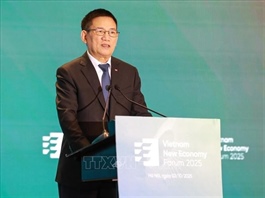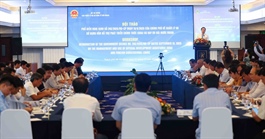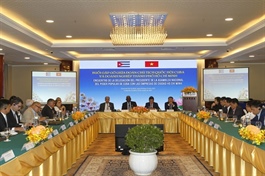Vietnam tasked to boldly shift from assembly to R&D activities
Vietnam tasked to boldly shift from assembly to R&D activities
Experts and businesses have urged the development of large companies in Vietnam associated with key national infrastructure, as well as supporting digital transformation and technology for small and medium-sized enterprises.
At the Innovation Policy Forum 2025 held in Hanoi on October 1, participants noted that while Vietnam has become a production base for many corporations, the issue is how the country can participate further in the value chain.
Dang Tan Duc, director of Becamex Research and Development (R&D) Institute, said that Vietnam needs to boldly shift from simple assembly to R&D activities to create higher added value.
“The public-private management model helps enterprises provide services and optimise the operational efficiency and commercially of innovative platforms. This is a practical direction to improve productivity and encourage enterprises to develop endogenous technology,” he said.
Sandeep Bharathi, chairman of Marvell, said innovation has become a driving force for economic growth and a foundation for enhancing competitiveness in many developed countries. He suggested a tripartite cooperation model via the state, enterprises, and institutes
“The government creates a favourable legal framework and digital infrastructure; large enterprises lead the value chain and market; institutes and schools provide new human resources and knowledge,” Bharathi said. “Vietnam has the potential to become a regional semiconductor and innovation centre, if it can take advantage of cooperation opportunities with global corporations.”
According to the Institute for Policy and Strategy Studies (IPS) under the Party Central Committee’s Commission for Policies and Strategies, Vietnam’s innovation process still has many limitations: production technology depends on imports, research and development (R&D) capacity is low, enterprises are small and lack capital, and the rate of tech transfer from foreign-invested enterprises is limited.
“It is necessary to build a strategy for developing a platform industry based on innovation, increasing tech autonomy through R&D investment and tax incentives, developing venture capital funds, and perfecting the innovation ecosystem with incubators and international connections,” said Dang Duc Anh, deputy director of the IPS.
At the local level, Danang is considered a typical example of turning policy into motivation. Ho Quang Buu, Vice Chairman of Danang People’s Committee, said that the locality has led the Vietnam ICT Index for 14 consecutive years. In 2021-2025, the city attracted more than $2 billion in technology investment, creating 20,000 high-quality jobs.
“One of the breakthrough solutions applied by Danang is to apply specific policy mechanisms, such as tax exemption for workers and tech enterprises, support for innovative startups, and allow controlled testing of new solutions,” Buu said.
He said that with these policies, the city has had started eight pilot projects. One of them is Basal Pay, the first cryptoasset conversion project in Vietnam licensed for testing, and the Danang Innovation and Startup Space project, which costs $20 million.
In addition to new policies, Danang also focuses on developing sci-tech infrastructure, specifically software parks and regional data centres. It is also accelerating development of digital government, AI applications, and automation of public administrative processes.
Prof. Tsuyoshi Usagawa from Kumamoto University said that to form an innovation ecosystem, there needs to be close coordination between the government, universities, and businesses, in which policy plays a driving role.
He pointed out three common directions of innovation: forming startups based on university research, businesses ordering research, and from community ideas through competitions.
“The challenge of the innovation process is the gap from laboratory research to the commercialisation stage. To overcome this, Japan uses crowdfunding mechanisms, under the auspices of universities or designs specific funding policies,” Usagawa said.
He added that the autonomy granted to universities since 2004 has also helped the country expand cooperation, commercialise intellectual property and form many technology startups.
“Young people have great potential to spur innovation, but they need to be provided opportunities and a favourable environment. To encourage innovation, we must invest in research and manage intellectual property well,” Usagawa added.
At the event, the Ministry of Science and Technology (MST) introduced a number of new strategic policies with the focus on supporting the formation and development of innovative startups, building a modern innovation ecosystem and international connections.
Nguyen Mai Duong, director general of the MST’s Department of Innovation, said, “The Law on Science, Technology and Innovation passed in June is a huge milestone. Currently, the MoST is taking the lead in developing a system of documents guiding the law implementation, especially documents on innovation.”
He added that there are currently many incentive policies for businesses to innovate, in the form of tax incentives, loan interest support, and funding support for businesses to invest in scientific research, tech transfer, and more.
There will also be financial support vouchers to encourage innovation and product commercialisation by facilitating businesses’ access to the market and encouraging users to experience new products and services.
In the coming time, each locality will have at least one innovation centre, and research institutes and universities will also be encouraged to establish centres.
- 09:00 06/10/2025
























